|
|
|
Sort Order |
|
|
|
Items / Page
|
|
|
|
|
|
|
| Srl | Item |
| 1 |
ID:
117619
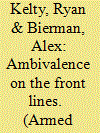

|
|
|
|
|
| Publication |
2013.
|
| Summary/Abstract |
In the past several decades, the US military has increasingly relied on civilian contractors to provide a variety of core functions. Lagging behind this increased reliance on contractors is an understanding of how the presence of contractors influences civilian and military personnel. This research addresses this question using a unique study of US Department of Army civilians and military personnel serving in Iraq and Afghanistan. We find a substantial degree of ambivalence among both groups regarding the impact of contractors on the military and comparisons with contractors, but we also find a noticeable trend of comparative discontent beneath this apparent ambivalence. Results are discussed in the context of using ambivalence as a starting point for building a theoretical approach to more systematically understanding the role and effects of contractor integration in the military.
|
|
|
|
|
|
|
|
|
|
|
|
|
|
|
|
| 2 |
ID:
117620


|
|
|
|
|
| Publication |
2012.
|
| Summary/Abstract |
Since late 2010, an unprecedented wave of protests demanding greater political freedoms, and in several countries even regime change, has swept across much of the Arab world. In Tunisia, Egypt, and Libya, long-standing autocrats have been toppled, and in other countries of the region seemingly well-established authoritarian regimes also appeared increasingly shaky in the face of growing opposition movements. The aim of this article is to examine the role of the armed forces in these popular uprisings. While military forces have been key actors in these Arab uprisings, they have responded quite differently across the region to prodemocracy movements, ranging from openness to protest movements, to internal fracturing, to firm support for the regime in power. This article argues that these differences can be explained with reference to different forms of civil-military relations and different characteristics of the military apparatus. It claims in particular that the degree of institutionalization of the armed forces and their relationship to society at large can account for the divergent responses to pro-reform movements.
|
|
|
|
|
|
|
|
|
|
|
|
|
|
|
|
| 3 |
ID:
117624
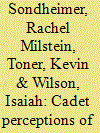

|
|
|
|
|
| Publication |
2013.
|
| Summary/Abstract |
Evidence of an actual or perceived gap in ideological beliefs between civilian and military communities informs current debates on the military and its relationship to broader society. The authors examine one cohort of the military and its members' perception of their own ideology in relation to their civilian counterparts using a 2009 survey of cadets at the United States Military Academy. The authors ascertain cadet perceptions of (1) cadet ideological leanings on individual and aggregate levels, (2) the ideological leanings of the civilian population, and (3) the civilian population's assessment of the military's ideological leanings. The authors attempt to discern whether or not this military subpopulation perceives itself as different from the rest of society. The authors find that while members of the Army's future officer corps perceive themselves as more conservative than their civilian peers and society writ large, as a group they hold rather moderate political views.
|
|
|
|
|
|
|
|
|
|
|
|
|
|
|
|
| 4 |
ID:
117625
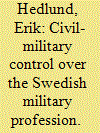

|
|
|
|
|
| Publication |
2012.
|
| Summary/Abstract |
Civil-military relations and the autonomy of the military profession in Sweden have varied over time depending on the perceived level of external threats. In this article, we set out to conduct an analysis of Swedish civil-military relations over a period of more than twenty-five years from 1984 to 2011. Our analysis is made from the perspective of civil-military control of (1) the military officer rank system and (2) the professional officer education system, for all three services. The analysis is based on Samuel Huntington's and Morris Janowitz's theoretical discussion of "objective" and "subjective" civilian control over the military and will give answers on how the Swedish armed forces have been effected by objective and subjective civilian control during the late Cold War era and after the fall of the Berlin Wall in 1989. The findings of this study confirm the assumption that civil-military relations vary over time because of perceived external threats but also because of new threats, new tasks, and increased globalization and cooperation in multinational international operations.
|
|
|
|
|
|
|
|
|
|
|
|
|
|
|
|
| 5 |
ID:
117622


|
|
|
|
|
| Publication |
2012.
|
| Summary/Abstract |
The U.S. Army consists of two distinct functional components: soldiers serving in combat roles, on the one hand, and those who serve in support positions, on the other. Do these two functionally distinct segments differ culturally as well? Empirical researchers utilizing qualitative methods have supported a "Two Armies" concept. This article examines the phenomenon quantitatively by using a nationally representative sample of the active duty population. The authors find that there is a statistically significant difference between support and combat soldiers that holds even after taking into account differing demography. Interestingly, this is true mainly of White soldiers, and the authors find that it is driven by premilitary, civilian socialization. This dataset also clearly shows that, for most soldiers, the split between the two segments of the Army tends to diminish over time, with combat and support soldiers sharing more similar motivations with one another later in their terms of service.
|
|
|
|
|
|
|
|
|
|
|
|
|
|
|
|
| 6 |
ID:
117623
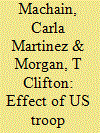

|
|
|
|
|
| Publication |
2013.
|
| Summary/Abstract |
Major powers often deploy troops abroad with the consent of host states. The stated aim of these deployments is often both to protect the host state and to foster stability in the region. Drawing from an extension of Palmer and Morgan's two-good theory of foreign policy, the authors explore some of the (perhaps unintended) effects of troop deployments abroad on the foreign policies of the host states. In particular, the authors focus on the effects of US deployments. The authors argue that as the number of US troops deployed to a host state increases, we should expect the host state to reduce its own troop levels, be more likely to initiate militarized interstate disputes, and be less likely to be the target of interstate disputes. The authors test these hypotheses using data on US troop deployments abroad from 1950 to 2005 and discuss implications that their findings may have for US foreign policy.
|
|
|
|
|
|
|
|
|
|
|
|
|
|
|
|
| 7 |
ID:
117626


|
|
|
|
|
| Publication |
2013.
|
| Summary/Abstract |
This study examines labor market status of Veterans of the Iraq/Afghanistan-era and previous eras, and variations by age and by health status, using the Current Population Survey (CPS) March supplement from 2006 to 2011. Although this observational study does not demonstrate a causal effect of military service on labor market outcomes, the authors find that Iraq/Afghanistan-era service among the youngest Veterans (ages 18-24) was associated with higher earnings and greater odds of being enrolled in school, but also higher odds of unemployment. Military service in previous eras by older Veterans, particularly those in fair or poor health, was associated with higher odds of unemployment and lower earnings than their nonveteran counterparts. Future research should examine the reasons for the higher unemployment rates of the youngest Veterans and should examine whether receipt of services such as health care services, disability benefits, and military reintegration programs are associated with improved labor market outcomes.
|
|
|
|
|
|
|
|
|
|
|
|
|
|
|
|
| 8 |
ID:
117621
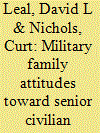

|
|
|
|
|
| Publication |
2013.
|
| Summary/Abstract |
This article examines Army spousal attitudes toward senior civilian leaders in the United States. Based on the 2004 Military Families Survey, it investigates the demographic, political, and institutional factors that structured the job approval ratings of then-President George W. Bush, Secretary of Defense Donald Rumsfeld, and Secretary of State Colin Powell. Partisanship, race and ethnicity, and opinions about the war in Iraq were consistently significant predictors; experiences directly related to the Iraq war were not. For instance, while Republicans and Latinos were highly likely to support the leadership, past and present deployments were not significant. In addition, Army spouses appear to have distinguished between the three leaders. The results have implications for researchers interested not only in military families but also the role of race and ethnicity in the armed forces, retention dynamics, the civil-military gap, and the Army in a time of war.
|
|
|
|
|
|
|
|
|
|
|
|
|
|
|
|
| 9 |
ID:
117627
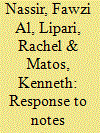

|
|
|
|
|
| Publication |
2013.
|
| Summary/Abstract |
The Defense Manpower Data Center (DMDC) of the US Department of Defense conducted a survey of active duty spouses in 2006. In Notes Regarding the 2006 Survey of Active Duty Spouses, Willard C. Losinger suggests that "Severe problems existed with the sampling, weight adjustments, and estimation (including variance-estimation) procedures." DMDC's review of these claims has revealed that Losinger used a preliminary data set with incorrect weighting variables to conduct his analyses. This data set was not used in any of DMDC's published results. Therefore, the article's claims about the quality of DMDC's published data and survey methods lack the necessary empirical support to be useful in improving the DMDC survey program.
|
|
|
|
|
|
|
|
|
|
|
|
|
|
|
|
|
|
|
|
|